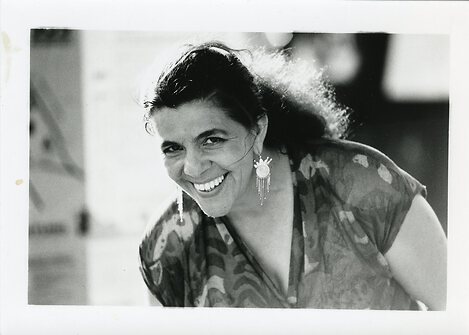Ružake gila (Ruža's songs)
 Ruža Nikolić-Lakatos © Mehmet Emir
Ruža Nikolić-Lakatos © Mehmet Emir
Brief description:
"Ružake gila" deals with the musical legacy of the singer Ruža Nikolić-Lakatos (1945-2022). The results are published as a digital exhibition, which is available in three languages (Lovara-Romani/German/English; project website). The project is part of MMRC's contribution to the celebrations set up by various organizations to mark the 30th anniversary of the recognition of the Romani people in Austria as a so-called "Volksgruppe" (ethnic minority). MMRC’s collaboration partners are Christiane Fennesz-Juhasz (ethnomusicologist, Phonogrammarchiv of the Austrian Academy of Sciences), Mozes F. Heinschink (Romanes expert) and Manuela Nikolić (daughter of Ruža Nikolić-Lakatos).
Ruža had a remarkable career as a singer, repeatedly appearing as an "ambassador of Romani culture". In this respect, her career also reflects the development of the Roma movement in Austria. The political significance of music becomes clear again and again, for example in the "Oberwart Song" Phurde bajval phurde, which Ruža wrote five days after the Oberwart bomb attack.
Ursula Hemetek accompanied Ruža's artistic development for more than three decades and worked closely with the family over the years. Therefore, a long-term documentation of Ruža's songs exists in the archive of the Department of Folk Music Research and Ethnomusicology at mdw. The archive holds over 100 hours of sound recordings, the first recording dating from October 25, 1989, and includes recordings of exploratory fieldwork at Ruža’s home (conversations and songs) as well as recordings of public performances. This material represents a treasure of documents on Lovara song culture, which, on Ruža's initiative, was included in the UNESCO List of Intangible Cultural Heritage in Austria in 2011. Only a small part of these recordings has been published and is thus accessible to the public. In addition, the Phonogrammarchiv of the Austrian Academy of Sciences contains numerous recordings of Ruža, including some from the Heinschink Collection, some of which were made as early as 1960. These audio recordings are supplemented by many other materials and documents in archives and private collections that document Ruža's development.
Based on this rich source material and in close consultation with Ruža's family, a digital exhibition has been developed. The focus is on selected songs, which are presented with recordings, lyrics and melody transcriptions, and lyrics translations, and are accompanied by commenting texts and, if suitable, other media (e.g., photos). These texts and other media explain the songs in a narrower sense, but also address, for example, aspects of Ruža's biography or socio-cultural and historical contexts. Thus, the selected songs allow for the discussion of a wide range of topics, and the open conception of the exhibition makes it possible to add new thematic focuses in subsequent projects. The development of the exhibition goes hand in hand with a reflection on goals and contemporary means and forms of remembrance culture.

Project lead: Ursula Hemetek
Project team: Eva Leick, Malik Sharif
Project duration: 2023-2025
Funding: Austrian Science Fund FWF Grant-DOI 10.55776/Z352